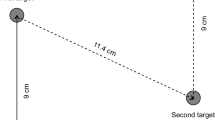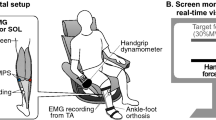Abstract
During voluntary muscle contraction, sensory information induced by electrostimulation of the nerves supplying the contracting muscle is inhibited and the amplitude of the corresponding somatosensory evoked potential (SEP) decreases. This phenomenon is called “gating.” The reduction of the SEP amplitude is reportedly significantly larger when task performance is high. However, the relationship between dexterous movement skills and gating remains unclear. In this study, we investigated through a ball rotation (BR) task how dexterous movement skills affect the SEP amplitudes. Thirty healthy subjects performed the BR task comprising the rotation of two wooden balls as quickly as possible. We estimated the median number of ball rotations for each participant and classified the participants into two (fast and slow) groups based on the results. Moreover, we recorded SEPs, while the subjects performed BR tasks or rested. SEP amplitude reduction (P45) was significantly larger in the fast than in the slow group. We also observed that the P45 amplitude during the BR task was attenuated even more so in the case of the participants with better dexterous movement skills. Our results suggest that the participants with better dexterous movement skills might display stronger somatosensory information suppression because of increasing the motor cortex activity and the afferent input during the BR task.




Similar content being viewed by others
References
Allison T, McCarthy G, Wood CC, Jones SJ (1991) Potentials evoked in human and monkey cerebral cortex by stimulation of the median nerve. A review of scalp and intracranial recordings. Brain 114:2465–2503
Bernardi NF, Darainy M, Ostry DJ (2015) Somatosensory contribution to the initial stages of human motor learning. J Neurosci 35:14316–14326
Cohen D, Cuffin BN (1983) Demonstration of useful differences between magnetoencephalogram and electroencephalogram. Electroencephalogr Clin Neurophysiol 56:38–51
Cohen D, Cuffin B (1987) A method for combining MEG and EEG to determine the sources. Phys Med Biol 32:85
Desmedt JE, Cheron G (1981) Non-cephalic reference recording of early somatosensory potentials to finger stimulation in adult or aging normal man: differentiation of widespread N18 and contralateral N20 from the prerolandic p22 and N30 components. Electroencephalogr Clin Neurophysiol 52:553–570
Enomoto H, Ugawa Y, Hanajima R et al (2001) Decreased sensory cortical excitability after 1 Hz rTMS over the ipsilateral primary motor cortex. Clin Neurophysiol 112:2154–2158
Hiraoka K, Kori C, Sato K (2017) The somatosensory-evoked potential in reaction time is gated and elicited earlier when the motor response to a somatosensory cue is faster. NeuroReport 28:451–456
Hoshiyama M, Sheean G (1998) Changes of somatosensory evoked potentials preceding rapid voluntary movement in Go/No-go choice reaction time task. Brain Res Cogn Brain Res 7:137–142
Hupfeld KE, Ketcham CJ, Schneider HD (2017) Transcranial direct current stimulation (tDCS) to the supplementary motor area (SMA) influences performance on motor tasks. Exp Brain Res 235:851–859
Inui K, Wang X, Tamura Y, Kaneoke Y, Kakigi R (2004) Serial processing in the human somatosensory system. Cereb Cortex 14:851–857
Ishikawa S, Matsunaga K, Nakanishi R et al (2007) Effect of theta burst stimulation over the human sensorimotor cortex on motor and somatosensory evoked potentials. Clin Neurophysiol 118:1033–1043
Johansson RS (1998) Sensory input and control of grip. Novartis Found Symp 218:45–63
Johansson RS, Flanagan JR (2009) Coding and use of tactile signals from the fingertips in object manipulation tasks. Nat Rev Neurosci 10:345–359
Jones S (1981) An ‘interference’ approach to the study of somatosensory evoked potentials in man. Electroencephalogr Clin Neurophysiol 52:517–530
Jones EG, Coulter JD, Hendry SH (1978) Intracortical connectivity of architectonic fields in the somatic sensory, motor and parietal cortex of monkeys. J Comp Neurol 181:291–347
Jones SJ, Halonen JP, Shawkat F (1989) Centrifugal and centripetal mechanisms involved in the ‘gating’of cortical SEPs during movement. Electroencephalogr Clin Neurophysio 74:36–45
Kakigi R, Koyama S, Hoshiyama M, Kitamura Y, Shimojo M, Watanabe S, Nakamura A (1996) Effects of tactile interference stimulation on somatosensory evoked magnetic fields. NeuroReport 7:405–408
Kakigi R, Hoshiyama M, Shimojo M et al (2000) The somatosensory evoked magnetic fields. Prog Neurobiol 61:495–523
Kawashima R, Matsumura M, Sadato N et al (1998) Regional cerebral blood flow changes in human brain related to ipsilateral and contralateral complex hand movements - a PET study. Eur J Neurosci 10:2254–2260
Kirimoto H, Tamaki H, Suzuki M, Matsumoto T, Sugawara K, Kojima S, Onishi H (2014) Sensorimotor modulation differs with load type during constant finger force or position. PLoS ONE 9:e108058
Lei Y, Ozdemir RA, Perez MA (2018) Gating of sensory input at subcortical and cortical levels during grasping in humans. J Neurosci 38:7237–7247
Lei Y, Perez MA (2017) Cortical contributions to sensory gating in the ipsilateral somatosensory cortex during voluntary activity. J Physiol 595:6203–6217
Matthews PB (1981) Evolving views on the internal operation and functional role of the muscle spindle. J Physiol 320:1–30
Mauguière F, Desmedt JE, Courjon J (1983) Astereognosis and dissociated loss of frontal or parietal components of somatosensory evoked potentials in hemispheric lesions. Detailed correlations with clinical signs and computerized tomographic scanning. Brain 106:271–311
Nagamine T, Kajola M, Salmelin R, Shibasaki H, Hari R (1996) Movement-related slow cortical magnetic fields and changes of spontaneous MEG-and EEG-brain rhythms. Electroencephalogr Clin Neurophysiol 99:274–286
Ohashi H, Gribble PL, Ostry DJ (2019) Somatosensory cortical excitability changes precede those in motor cortex during human motor learning. J Neurophysiol 122:1397–1405
Papakostopoulos D, Cooper R, Crow HJ (1975) Inhibition of cortical evoked potentials and sensation by self-initiated movement in man. Nature 258:321–324
Pavlova E, Kuo MF, Nitsche MA, Borg J (2014) Transcranial direct current stimulation of the premotor cortex: effects on hand dexterity. Brain Res 1576:52–62
Pearce AJ, Thickbroom GW, Byrnes ML, Mastaglia FL (2000) Functional reorganisation of the corticomotor projection to the hand in skilled racquet players. Exp Brain Res 130:238–243
Puce A, Hämäläinen MS (2017) A review of issues related to data acquisition and analysis in EEG/MEG studies. Brain Sci 7:58
Rauch R, Angel RW, Boylls CC (1985) Velocity-dependent suppression of somatosensory evoked potentials during movement. Electroencephalogr Clin Neurophysiol 62:421–425
Reid LB, Sale MV, Cunnington R, Mattingley JB, Rose SE (2017) Brain changes following four weeks of unimanual motor training: evidence from fMRI-guided diffusion MRI tractography. Hum Brain Mapp 38:4302–4312
Ridding MC, Brouwer B, Nordstrom MA (2000) Reduced interhemispheric inhibition in musicians. Exp Brain Res 133:249–253
Rivera-Urbina GN, Batsikadze G, Molero-Chamizo A, Paulus W, Kuo MF, Nitsche MA (2015) Parietal transcranial direct current stimulation modulates primary motor cortex excitability. Eur J Neurosci 41:845–855
Rothwell JC, Traub MM, Day BL, Obeso JA, Thomas PK, Marsden CD (1982) Manual motor performance in a deafferented man. Brain 105:515–542
Rushton DN, Rothwell JC, Craggs MD (1981) Gating of somatosensory evoked potentials during different kinds of movement in man. Brain 104:465–491
Seyal M, Ortstadt JL, Kraft LW, Gabor AJ (1987) Effect of movement on human spinal and subcortical somatosensory evoked potentials. Neurology 37:650–650
Staines W, Brooke J, Misiaszek J, McIlroy W (1997) Movement-induced gain modulation of somatosensory potentials and soleus H-reflexes evoked from the leg II. Correlation with rate of stretch of extensor muscles of the leg. Exp Brain Res 115:156–164
Sugawara K, Onishi H, Yamashiro K et al (2016) Effect of muscle contraction strength on gating of somatosensory magnetic fields. Exp Brain Res 234:3389–3398
Wasaka T, Nakata H, Kida T, Kakigi R (2005) Changes in the centrifugal gating effect on somatosensory evoked potentials depending on the level of contractile force. Exp Brain Res 166:118–125
Wasaka T, Kida T, Nakata H, Kakigi R (2006) Pre-movement modulation of tibial nerve SEPs caused by a self-initiated dorsiflexion. Clin Neurophysiol 117:2023–2029
Wasaka T, Kida T, Kakigi R (2017) Facilitation of information processing in the primary somatosensory area in the ball rotation task. Sci Rep 7:1–9
Wasaka T, Kida T, Kakigi R (2021) Dexterous manual movement facilitates information processing in the primary somatosensory cortex: a magnetoencephalographic study. Eur J Neurosci 54:4638–4648
Yamashiro K, Sato D, Onishi H, Yoshida T, Horiuchi Y, Nakazawa S, Maruyama A (2013) Skill-specific changes in somatosensory-evoked potentials and reaction times in baseball players. Exp Brain Res 225:197–203
Acknowledgements
We would like to thank all participants for taking part in this study.
Author information
Authors and Affiliations
Contributions
All authors contributed to the conception and design of the study. Material preparation and data collection were performed by MA, KS, YM, YS, and HS. Data analyses were performed by MA. The first draft of the manuscript was written by MA. The manuscript was edited by KS. All authors commented on earlier versions of the manuscript and read and approved the final version.
Corresponding author
Ethics declarations
Conflict of interest
The author(s) declare no competing interests.
Ethical approval
All procedures performed in studies involving human participants were in accordance with the ethical standards of the institutional and/or national research committee [Sapporo Medical University (No. 2-1-91)] and with the 1964 Helsinki declaration and its later amendments or comparable ethical standards.
Consent for publication
All participants signed informed consent regarding publishing their data.
Consent to participate
Informed consent was obtained from all individual participants included in the study.
Additional information
Communicated by Winston D Byblow.
Publisher's Note
Springer Nature remains neutral with regard to jurisdictional claims in published maps and institutional affiliations.
Supplementary Information
Below is the link to the electronic supplementary material.
Rights and permissions
Springer Nature or its licensor holds exclusive rights to this article under a publishing agreement with the author(s) or other rightsholder(s); author self-archiving of the accepted manuscript version of this article is solely governed by the terms of such publishing agreement and applicable law.
About this article
Cite this article
Akaiwa, M., Matsuda, Y., Soma, Y. et al. The relationships between motor behavior and sensory gating in the ball rotation task. Exp Brain Res 240, 2659–2666 (2022). https://doi.org/10.1007/s00221-022-06439-y
Received:
Accepted:
Published:
Issue Date:
DOI: https://doi.org/10.1007/s00221-022-06439-y




